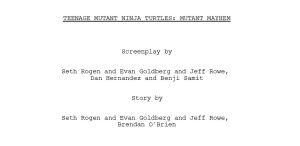The Teenage Mutant Ninja Turtles have been around since the ‘80s. They’ve starred in several animated TV series, live-action movies from Jim Henson costumes to CGI turtles, and two animated films. The latest, Teenage Mutant Ninja Turtles: Mutant Mayhem, reinvents the comic book heroes in several ways.
Perhaps taking a cue from the Spider-Verse movies, Mutant Mayhem uses an animation style that is not a straightforward depiction of its world. You can tell it’s New York and there are turtles and other mutants, but the animation combines styles like teenage sketchbooks to create a livelier viewing experience.
The film sticks to the turtles’ origins, mutated by green ooze along with their father figure, the rat named Splinter. The experiments by scientist Baxter Stockman (voice of Giancarlo Esposito) led to the creation of some familiar mutants like Bebop (Seth Rogen) and Rocksteady (John Cena), along with some new ones like Superfly (Ice Cube). The loaded voice cast also includes Ayo Edebiri as April O’Neil, Paul Rudd, Hannibal Buress, Rose Byrne and Post Malone.
For the four teenage turtles — Leonardo, Michelangelo, Donatello and Raphael — directors Jeff Rowe and Kyler Spears, with producers Rogen and Evan Goldberg, cast teenage actors Micah Abbey, Nicolas Cantu, Brady Noon and Sharon Brown Jr. This is why you’ll see the differences between what was scripted and the final film, as the filmmakers allowed the actors to improvise to capture the dynamics of real teenagers.
That included modern TikTok references even Rogen wasn’t familiar with. “I don’t know who the Ocky guy is but apparently the Ocky guy is hilarious,” Rogen said on a panel at Deadline’s Contenders Film: Los Angeles. “Tell him you love bacon egg and cheese and that’s a whole thing.”
Goldberg, who also co-wrote the script with Rogen, Rowe, Dan Hernandez and Benji Samit, said those improvisations influenced the final animation. The turtles just want to be accepted by humans and they follow along the same social media that human teens do.
“Some of the best jokes, we don’t understand,” Goldberg said. “One of our main theories was that to record all of them together would make it way better because that’s how teens are. They don’t wait for people to finish their sentences. It had a domino effect. It affected the animation, how we framed it, how many people were in the frame.”
Click below to read the script.
More from this Story Arc
Read The Screenplay Series

